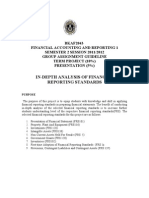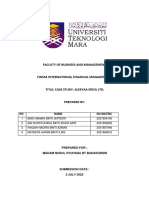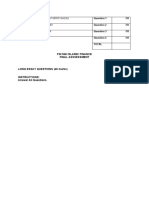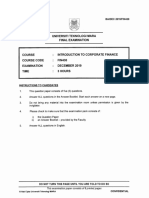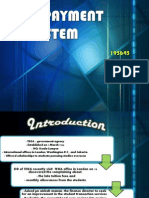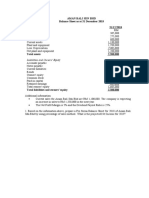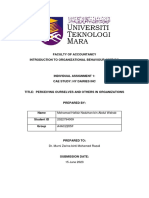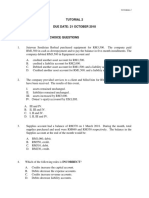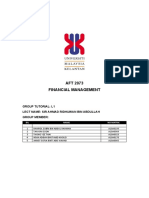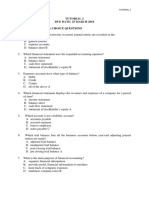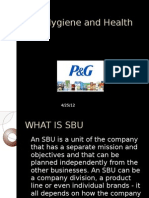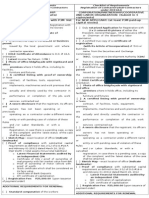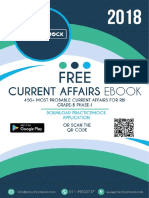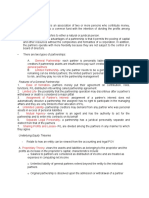Kolej Universiti Tunku Abdul Rahman Faculty of Accountancy, Finance and Business SEMESTER 2020/2021 BBMF 3073 Risk Management Tutorial 4 (Week 5)
Uploaded by
Wong Ji ChingKolej Universiti Tunku Abdul Rahman Faculty of Accountancy, Finance and Business SEMESTER 2020/2021 BBMF 3073 Risk Management Tutorial 4 (Week 5)
Uploaded by
Wong Ji ChingKOLEJ UNIVERSITI TUNKU ABDUL RAHMAN
FACULTY OF ACCOUNTANCY, FINANCE AND BUSINESS
SEMESTER 2020/2021
BBMF 3073 RISK MANAGEMENT
TUTORIAL 4 (WEEK 5)
1. Using the financial information below, determine the company’s stress position in terms
of corporate failure. Additional information includes that the average share price for the
period was RM1.40.
Total current assets (TCA) 1,182,000
Total non-current assets
1,700,000
(TNCA)
Total assets (TA) 2,882,000
Total current liabilities (TCL) 736,000
Total non-current liabilities
883,000
(TNCL)
Total liabilities (TL) 1,619,000
Shareholders' equity (SE) 109,000
Retained earnings (RE) 1,154,000
Number of shares issued
100,000
( NSI)
Profit before tax (PBT) 245,000
Sales (S) 3,393,000
Inventory (1) 435,000
X1 = Working Capital (Total Current Asset – Total Current Liability) /Total Assets.
= (1,182,000-736,000)/2,882,000
=0.1547
X2 = Retained Earnings/Total Assets.
=1,154,000/2,882,000
=0.4004
X3 = Earnings Before Interest And Taxes/ Total Assets.
=245,000/2,882,000
=0.0850
X4 = Market Value Equity/Total Liabilities.
=(100,000*1.40)/1,619,000
=0.0865
X5 = Sales/Total Assets
=3,393,000/2,882,000
=1.1773
Z-score is (1.2*x1 + 1.4*x2 + 3.3*x3 + 0.60*x4 + 0.999*x5)
Z−Score=(1.2× 0.1547)+(1.4 × 0.4004)+(3.3 ×0.085)+(0.0865× 0.60)+(1.1773 ×0.999)
=0.1856+0.5606+0.2805+0.0519+1.1761
=2.2547
[(3-2.2547) / (3-1.8)]*100%=62.11%
Based on the result, the company is in the risk of financial stress as the Z-score of the company is
2.2347 which is 62.11% towards the bankruptcy risk.
2. Define financial risk, credit risk and currency risk.
Financial risk
Financial risk is the exposure to adverse events that erode profitability and in the extreme
case bring about business collapse.
Credit risk
A credit risk is the risk of default on a debt that may arise from a borrower failing to
make required payments.
Currency risk
It is the possibility that currency depreciation will negatively affect the value of one's
assets,investments and their related interest and dividend payment streams, especially
those securities denominated in foreign currency.
3. Discuss methods to implement financial risk management.
Develop financial discipline and internal control
A good financial discipline allows you to conform your spending and saving to the plans
that you have set to achieve your monetary goals and minimize financial loss. Second,
establishing an ethical environment and setting the tone at the top of the organization
allow each of the components to work together to create a comprehensive system capable
of deterring fraud, and preventing, detecting, and correcting problems based on an overall
assessment of risk and exposure.
Develop concise reporting tools
A concise reporting tool helps users to translate data into actionable information to
develop strategies against any potential financial risk.
Prepare cash budget
A cash budget involves a realistic assessment of how much money you will have coming
in during an upcoming period. Your determinations of how much money your business
has available to spend are based on these forecasts, forcing you to spend within your
means. It forces you to restrict discretionary purchases to items that you can pay for out
of the cash you have on hand to avoid overspending.
Purchase credit insurance
Trade Credit Insurance will protect your business with account receivable protection
against losses due to credit risks such as customer’s insolvency, bankruptcy and failure to
meet agreed payment terms and conditions. Thus, it gives you the confidence to grow
your business by minimizing your credit risk exposure and improving your financial risk
management. Monitor change in interest rate, inflation rate and exchange rate. Generally,
financial markets are volatile and unstable, and these could potentially result in losses for
businesses and investors. A well monitoring of interest rate, inflation rate and exchange
rate allow you to avoid financial risk and minimize the impact by quick responses.
4. Discuss any three qualitative factors that predict corporate failures.
Decline in industry
Industries that have experienced negative growth or stagnant due to a decline in demand
for one or more products for a variety of reasons. This includes, but is not limited to,
economic downturns, product downgrades or upgrades, and technological changes. For
example, the tape industry performed well before the launch of the CD, making the tape
industry a recession.
Poor in management quality
Poor quality management is the situation where quality falls behind. This could cost a
business more than just repairs, replacements, and refunds. They often end up losing the
trust of customers for future purchases as well. For example, like No customer support
for the product inquiries, turnover very high and also overstaffed.
Poor organization culture
A poor organisation culture can increase employee turnover because no one wants to
stick to it in their tragic place. If you understand culture outside the company, it may
become more difficult to attract new employees. For example, poor internal
communication, a lack of team spirit in the office can be toxic to a business.
5. Discuss how risk impact on the market value of a firm?
Management of risk is an integral part of good practice and quality management.
Learning how to manage risk effectively enables managers to improve outcomes by
identifying and analyzing the range of issues and providing a systematic way to make
informed decisions. So the primary objective of a business is to maximize the wealth of
its shareholders. For example, the companies regularly face the decision of allocating net
revenues (profits) between retained earnings and dividends or share buy-backs. A central
issue is the opportunity to invest retained earnings and the cost financing alternative. A
firm can finance new projects or investments through either internal (retained) or external
capital resources. Under the theory of perfect capital markets, a firm should distribute all
earnings it does not need in the immediate future and simply issue more equity to finance
new initiatives. However, in the real world, returning money to shareholders and
reissuing equity incurs transaction costs. Even worse, if a firm finds itself in financial
distress and needs external financing to keep operations a float, potential investors may
be unsympathetic in the price they charge for that financing. The high cost of such
distressed financing is an incentive to retain earnings as an internal capital cushion.
You might also like
- FRM Part - 1 Mock 1 - May 2023 - Complete Test - Questions100% (1)FRM Part - 1 Mock 1 - May 2023 - Complete Test - Questions27 pages
- 43 Best Passive Income Streams & Opportunities50% (2)43 Best Passive Income Streams & Opportunities7 pages
- With Regards To Expiration Date Futures Contracts: CardsNo ratings yetWith Regards To Expiration Date Futures Contracts: Cards4 pages
- Importance of MFRS 8 Operating Segments For Accounting User100% (1)Importance of MFRS 8 Operating Segments For Accounting User5 pages
- Ocean Management SDN BHD: Is A Modus Operandi Change Necessary? (Question 3)No ratings yetOcean Management SDN BHD: Is A Modus Operandi Change Necessary? (Question 3)25 pages
- Accounting Analysis (Analyzing Financing Activities)No ratings yetAccounting Analysis (Analyzing Financing Activities)19 pages
- Contoh - Fin-552-Group-Assignment-Bursa-Marketplace-Stock-Trading-GameNo ratings yetContoh - Fin-552-Group-Assignment-Bursa-Marketplace-Stock-Trading-Game22 pages
- BBMF3113 CSFI Case Study 1 Written ReportNo ratings yetBBMF3113 CSFI Case Study 1 Written Report18 pages
- Swot Analysis of Hong Leong Financial Group100% (1)Swot Analysis of Hong Leong Financial Group3 pages
- Advanced Tax - KPHDN V Multi-Purpose Holdings BHD 2002No ratings yetAdvanced Tax - KPHDN V Multi-Purpose Holdings BHD 200218 pages
- Fin358 - Individual Assignment - Norsyafiqah - 2019250896 - Ba1115gNo ratings yetFin358 - Individual Assignment - Norsyafiqah - 2019250896 - Ba1115g13 pages
- This Study Resource Was: Common Test - Suggested Answers Aud 689 - Audit and Assurance ServicesNo ratings yetThis Study Resource Was: Common Test - Suggested Answers Aud 689 - Audit and Assurance Services4 pages
- MFRS 2 SHARE BASED PAYMENTS - ALL COMBINED - Part 1 - 4No ratings yetMFRS 2 SHARE BASED PAYMENTS - ALL COMBINED - Part 1 - 481 pages
- Test 1 Name: Nurul Shafirah Binti Norwadi STUDENT ID: 2019802212 GROUP: BA2425B0% (1)Test 1 Name: Nurul Shafirah Binti Norwadi STUDENT ID: 2019802212 GROUP: BA2425B2 pages
- Tutorial 6: Jane Lazar and Huang (4 Edition) - Chapter 35-MFRS133100% (1)Tutorial 6: Jane Lazar and Huang (4 Edition) - Chapter 35-MFRS13315 pages
- Assignment / Tugasan - Financial Accounting0% (1)Assignment / Tugasan - Financial Accounting10 pages
- AFT 2073 Financial Management: Group Tutorial: L1 Lect Name: Sir Ahmad Ridhuwan Bin Abdullah Group MemberNo ratings yetAFT 2073 Financial Management: Group Tutorial: L1 Lect Name: Sir Ahmad Ridhuwan Bin Abdullah Group Member25 pages
- Individual Assignment 1 (Rienah Binti Sanari, 2019231122)No ratings yetIndividual Assignment 1 (Rienah Binti Sanari, 2019231122)9 pages
- Benefits of Harmonisation and ConvergenceNo ratings yetBenefits of Harmonisation and Convergence3 pages
- Discuss The Arguments For and Against Regulating The Financial Reporting System100% (10)Discuss The Arguments For and Against Regulating The Financial Reporting System9 pages
- RA 8762 Retail Trade Liberalization Act of 2000No ratings yetRA 8762 Retail Trade Liberalization Act of 20004 pages
- The Foreign Exchange Management (Permissible Capital Account Transactions) Regulations, 2000No ratings yetThe Foreign Exchange Management (Permissible Capital Account Transactions) Regulations, 20004 pages
- Template For Accounting Company Annual Report PDF Doc PPT Document Report TemplateNo ratings yetTemplate For Accounting Company Annual Report PDF Doc PPT Document Report Template29 pages
- Finance: 6.introduction To Project Financing (5 HRS)No ratings yetFinance: 6.introduction To Project Financing (5 HRS)25 pages
- ICCT Colleges Foundations, Inc.: Chapter 3 - ActivityNo ratings yetICCT Colleges Foundations, Inc.: Chapter 3 - Activity2 pages
- Lecture 1.5 Concept and Objectives of Capital StructureNo ratings yetLecture 1.5 Concept and Objectives of Capital Structure13 pages
- Module-1 Introduction and Time Value of MoneyNo ratings yetModule-1 Introduction and Time Value of Money46 pages
- Small Business Management Study Questions - CH 6 The Business Plan - Visualizing The Dream100% (1)Small Business Management Study Questions - CH 6 The Business Plan - Visualizing The Dream19 pages










